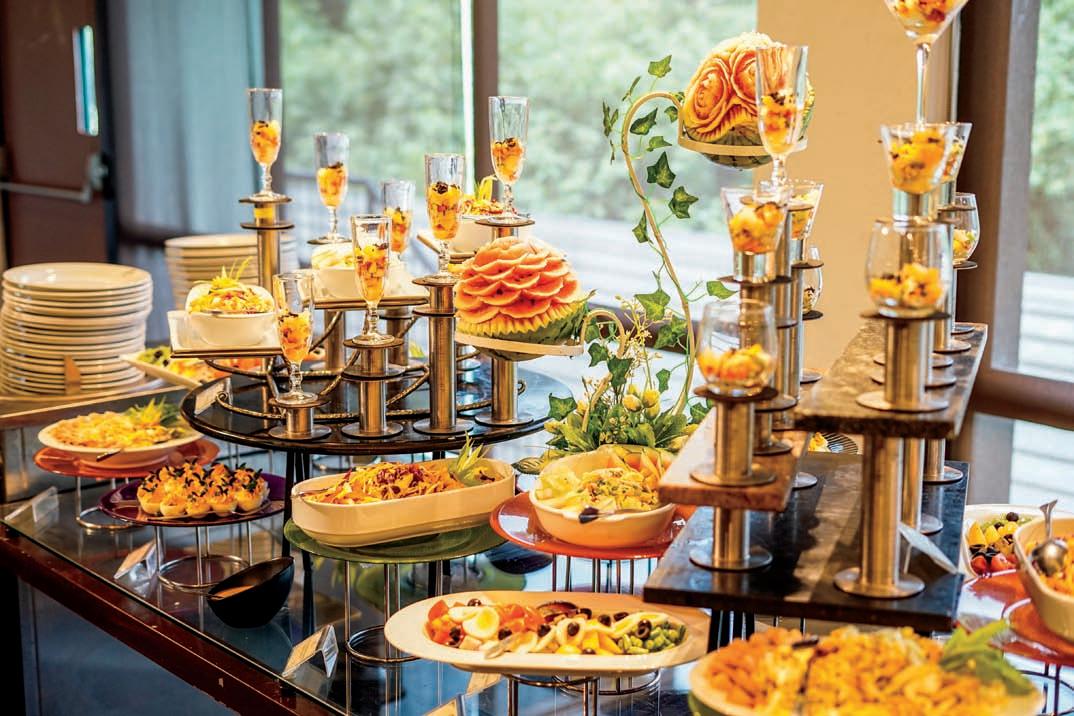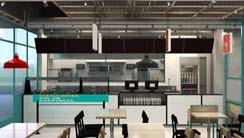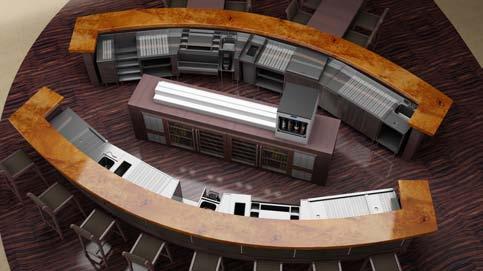
9 minute read
F&B
Buff your Buffets
The buffet is emerging as one of the essential elements in food service operations. What was earlier a service style meant for function (mass) catering is increasing being accepted in restaurants as well. So much so, that the buffet has become an indispensable part of most coffee shops or 24 hour eateries. Many a time a buffet defines the character of the coffee shop. The following are some essential elements in a buffet, which, if cared for, can make the buffet the USP of an outlet and be a cost effective yet stylish style of food service.
Advertisement
Composition: In India, buffets are generally multi-cuisine and have a mix of Indian, Continental, and Chinese cuisine with a salad bar and a dessert counter. The key to a successful buffet is to have something for everyone, i.e. acceptability to a maximum number of people. In a hotel, guests usually fall into two categories - in house guests and local guest. The buffet must appeal to both clienteles.
In house guests: As a lot of in-house guests, especially who are on meal plans, depend on the coffee shop buffets, one has to provide a basic continental fare, like popular salads, breads, Classical dishes and accompaniments like steamed vegetables. For these guests, one has to have a complete salad counter with essentials like lettuce, relishes like olives, gherkins etc. A balance between composite salads and simple salads (just one ingredient) must be maintained.
Local guests: For local clientele the buffet should hold some good Indian food and Continental dishes, which are suitable to Indian tastes. These guests look for quantity in the buffet (as well as quality) as far as the number of dishes are concerned. The salad and cold buffets are becoming increasingly popular with locals, too, for dietary reasons. Consequently the decision of whether to order Ala Carte or choose the buffet often rests with the kind of salad/ cold display the buffet boasts of. Indian guests prefer to eat some simple home food like a pulao and dal with vegetables, which is why many buffets devote a counter for “ghar ka khana.”
The following are guidelines for composition of each section of the buffet with respect to quantity and static dishes, which should always be there:
Salads
• Lettuce is the most basic and important part of a salad. Make sure more than one variety of lettuce is displayed of excellent quality. Lettuce should be washed very well and should always be fresh. Otherwise this can lead to a very poor beginning of a meal. • Composite salads: Always have one or two (not more than that) popular composite

salads like Russian, Waldorf or Nicoise etc. For others, let the chef experiment with unique (but not disastrous) combinations which appeal to the eye and the palette. • Other than composite salads, simple salads (single ingredient) should also be available. • Fresh ingredients may also be part of the buffet for guests to create their own salads. • Relishes and pickles are also important elements of the salad buffet. Pickled olives, gherkins onions or other root vegetables like carrots and radishes are deemed to be excellent appetizers. • Dressings: Different variants of vinaigrette (herbs, garlic, etc.) and mayonnaise (thousand island, cocktail) based dressings along with innovative combinations like honey lemon, minted yoghurt etc. must be part of the salad counter. • Cold Cuts: Depending on the pricing level, one should decide how many cold cuts are displayed. Salmon and imported ham (like Parma, Bayonne etc.) though very much liked can be expensive. In the absence of the above one or two homemade pates, terrines or galantines should be made with attractive garnishes. For Indians, who do not consume a lot of pork or beef, chicken salami/ mortadella is a likable option. • Cheese: Imported cheeses are a common sight in many five star hotel buffets. To increase variety and keep costs bearable, one should combine imported cheeses with Indian made Foreign Cheese from leading local cheese producers. At least one of each, soft, semi hard and blue cheese, should always be displayed. For attractive presentation a whole block of cheese (especially Parmesan) is often showcased. • Presentation: As this section is the face of the buffet it becomes imperative for it to look fresh, classy and attractive. One can use coloured glass bowls or plates of different shapes and sizes for salads. Elevations should be used to break monotony and make the whole presentation multidimensional. Other than the food one may display kitchen artifacts like oil and vinegar bottles, jars with pulses and pickled vegetables. • Temperature: Most salads are served cold. Therefore they should be placed on an inbuilt bed of ice or in absence of this on glass bowls or acrylic ice baths filled with ice. Whatever method is used the temperature must be maintained throughout the service period. Cheese should be served at room temperature and not chilled.
Brainstorming is Everything.
Come and meet us for brainstorming ideas for developing "The Big Idea" or the concept of your Hospitality Project.





THS consulting is an established company in the hospitality and food service design since 2013. We at THS Consulting are cultivating a new school of ambitious business owners in a new age. A full-service Food and Hospitality consultancy. We help you conquer challenges that are holding you back from being more successful, efficient and profitable. Most importantly, We get results.
Our Services includes :
Price Estimations. Project Timeline. Brief & Revisions. Project Delivery.
We Offer Consultancy for Projects:
Hotels Cafeteria Bakeries Food Court Industrial Canteens Restaurant Cloud Kitchen
Follow us on
THSConsultingPvtLtd
ths _ consulting
ths-consulting-pvt-ltd
WZ-91B, Second Floor Tatar Pur, Near Metro Pillar no 429, Near Tagore Garden Metro Station, New Delhi- 110027 Phone: (91) 11-42003320 Email: info@thsconsulting.in Mobile: 91-7838871875, 8377061530
Log on to know more

Main Course
• As discussed earlier restaurant buffets in coffee shops are multi-cuisine. As far as possible, different kinds of cuisines should be visibly separated into counters or windows. • The continental section must have non-vegetarian and vegetarian choices. Too much classical cuisine can be boring and unappealing. Nouvelle cuisine should be encouraged with a touch of Italian cuisine and Lebanese cuisine both of which are increasingly popular nowadays. • Continental food is generically not made with the distinction of being vegetarian or non-vegetarian, but keeping in mind the Indian culture provisions to distinguish the two should be made. Innovative combinations of vegetarian foodstuffs in international flavours should be included. • Many buffets showcase a “roast of the day” section whereby a roast is carved in front of the guest and served. Care should be taken that the roast is not dry and is served tender and hot with an appropriate sauce. • When selecting the dishes for the menu, one should choose dishes that have enough moisture and do not become dry after being on the buffet for some time. For example grilled pork chops with caramalised onions cannot go on a buffet, as the chops would become tough in no time. Dishes that have natural moisture in them like lasagna or baked vegetables, keep very well on the buffet. • As far as Indian food goes, one should have gravy as well as dry dishes accompanied with a rice preparation. DO NOT KEEP BREADS ON THE BUFFET. • If pasta is to be included in the buffet, the sauce and the pasta should be displayed separately. • It is preferable if kebabs are made on site, if part of the buffet. ]
Desserts
• A balance should be made between the number of Indian and Continental desserts that are part of the buffet. Generally buffets tend to have more western desserts as they allow the chef to be more creative in presentation. • All the western desserts should be of different base i.e. no two should have the same, mousse or sponge base. • Incorporate as many fresh fruits as possible in the dessert display. • Chocolate mousse, caramel custard and fresh fruits are static buffet items. Efforts to make variations in their presentation must be made. • All desserts should be displayed portion wise. All gateaux should be presliced for ease of service and maintenance of presentation. Imagine a beautifully decorated chocolate gateaux and just one spoon put into it by someone for serving can ruin the whole cake. Instead it can be neatly cut, individually decorated and put in small plates!
Themed/Specialty Buffets
Buffets can also become monotonous if the same pattern is repeated often. Adding a theme to part of the buffet, or having something other than the usual fare available can maintain novelty in the buffet.
Food promotions can also be sold through the buffet. If there is an Ala Carte promotion of a particular specialty food, a few of the dishes can be incorporated in the buffet as well. Or at times the whole promotion is on the buffet. For example various micro cuisines of India like Rajasthani, Karawali, Hyderabadi etc. can be served in the Indian section. This should be highlighted through proper props on the buffet.
Having specialty items on a particular day of the week can be incorporated in the buffet matrix to break the monotony, for example a seafood special every Friday or pasta for lunch on Monday and so on. All this helps the guest to remember the buffet for something special.
Buffet Maintainance
• Temperature: The most frequent guest dissonance regarding buffets is that the food is not served hot. Modern restaurants have inbuilt induction heating but most still depend on solid fuel at some point in the display. Proper monitoring of the fuel during the operation is of utmost importance. Food should be placed in smaller portions and replenished frequently; this maintains the temperature as well as freshness of the food. • Cleanliness: During operations the staff often neglects the cleanliness of the buffet. This destroys the aesthetic appeal of the buffet counter and leaves a poor impression of the establishment on the guest. Spillages around the buffet counters and edges of food pans with dried gravies etc. are common areas that should be monitored. An eye for detail on the part of the person responsible for maintainance/ replenishment of the buffet can make a difference. • Dish tags: The tags that label each dish in the buffet assist the dishes in up selling themselves. Care should be taken to ensure that the names of dishes are spelt correctly and any descriptions given are self-explanatory. Additionally, a colour code on the tag can help in identifying a dish as vegetarian or non-vegetarian.
The whole idea behind the buffet is ease of service, getting more variety and showcasing a chef’s skill. As all the above work well for both the restaurant as well as the guest, one needs to pay a lot of attention to the buffets composition, presentation and maintenance. A good buffet should look as fresh as it has just been laid and each guest who approaches it should feel it is fresh and appealing. n











